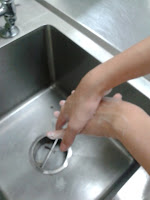Some examples of bad kitchen cleanliness:
1) Using the same cloth for wiping the plates and cleaning the tables.
Thousands of bacteria can be found on table tops and when we use the same cloth to wipe the plate, the germs will be transferred over to the plate and causes the plate to be contaminated.
2) Using the wrong chopping board for the wrong purposes.
Different coloured chopping boards are used for specific foods. For example: Red for raw meat, Yellow for raw poultry, Green for vegetables and fruits, Brown for seafood and Blue/White for ready-to-eat foods.
By using the right chopping board for each category, you can prevent cross contamination from happening.
3) Not clearing the garbage at the end of every single day.
Garbage cans are moist, dark and at room temperature, which is the optimum temperature for bacteria growth to happen. Every time wastes get thrown into the garbage can, the bacteria count increases. Leaving the garbage can overnight without clearing it, can you imagine how much bacteria would have grown and infested your kitchen?
Fret not, here are some ways to ensure proper cleanliness in your kitchen:
- Keep utensils, appliances and food items in most suitable places.
- End each day with proper cleaning of your kitchen. (Mopping of floors, cleaning of cabinets)
- Do NOT use the same plates and utensils to hold raw and cooked products.
And most importantly,
- Wash all your equipments and utensils thoroughly with soap and water after use.



















